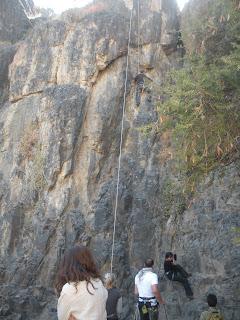Shortly after New Year’s, D persuaded me to go rock climbing with her. In fact, the idea greatly appealed to me but every previous opportunity I had declined, resting on the lame excuse of needing to do homework or wanting to just relax. The Yemen Adventure club met Fridays at 10:00am in the parking lot of a grocery store in the south side of the city. Having only one real day off of work, it took me until January to decide it was time to spend that one day rock climbing, even though it’s a hobby I’ve always wanted to explore more.
The Yemen Adventure Club was founded by Joshua Maricich, a writer living long-term in Sana’a working on a book about the historic Old City. An avid outdoorsman, he along with a British expat buddy founded the club as way to bring their enthusiasm for climbing to Yemen while promoting environmental awareness. When I made it out to climb with the club in early 2011, they were in the midst of registering as an NGO. Unfortunately Josh was deported not long after, charged with practicing journalism without the proper visa. It was a cheap political move on the part of the Yemeni government in an attempt to scare Western journalists from covering the building civil unrest.
I wasn’t sure what to expect when the taxi dropped us off in the supermarket parking lot that morning. The idea of a rock climbing club in Yemen seemed so surreal when picturing it in my head. The day’s climbers were already gathering when we arrived. D had been once before and introduced me around; they were all free lance journalists or expat aid workers aside from one Yemeni, Naz, who made sure the club continued after Josh’s deportation. Some of them I’d met previously at parties.
Naz and Josh arranged for a passing minibus (dabab) to take us to the routes. We drove away from the city center and up toward the surrounding mountains. After wending through a village we came to a narrow passage too steep for the minibus and piled out. From there we hiked to a small cinderblock building where the club kept their gear and continued on to the routes.
The rock face was steep, not quite 90 degrees. We were joined by three Yemenis from the nearby village: an older man fit-looking with graying hair, a younger one perhaps in his late teens or early twenties, and a young boy around eight or ten years old.
Four runs were mapped out in varying difficulty. Some had areas where the angle inverted slightly, other had portions where no obvious foot or hand holds presented themselves to navigate a particular gap. I sat out the first round before taking my first climb.
I re-learned how to put on the harness and tie the “figure eight” knot and off I went, anchored by one of the experienced climbers. The climb was thrilling. I hadn’t worked out much since coming to Yemen and I loved the feeling of doing something physical in a natural setting. I took to the climb well and finished with only a minor freak-out midway through when I paused clinging to some tiny hold, not seeing anywhere to go next before finally finding a way forward. Once at the top I repelled down.
One thing I never used in my few brief previous experiences climbing was climbing shoes. The toe of these specialty shoes squeezes the foot to a narrow point, under which is a hard sole designed to allow the foot to find purchase on the slightest variations of rock face. I imagine fitting your foot into this equipment is somewhat like fitting into a ballet shoe.
I managed three climbs before feeling completely exhausted. At some point we took a break to fire up the grill and charcoal provided by the club and we cooked lunch. We each brought our own food, and D and I made grilled tomato and mozzarella sandwiches (she’s a vegetarian).
Over lunch we met Sven, who worked with the UN on women’s issues. He wore a Boston Redsox cap and spoke in a college bro manner. We were shocked to learn he was a Swede, having mistaken him for American. D resolved to make him our American-style bro friend, something we were lacking at the time. Regretfully he and many other UN folk left Sana’a in mid March, and D and I shortly after, effectively cutting off her plans.
After lunch and a few climbs I wandered through the brush and thicket along the rock face away from where the routes were mapped and made my way to a rocky promontory. Standing there I had a wide view of the city below and could make out the specks of the climbers on the rock wall off to the left. The sun shone and it was peaceful and calm.
Toward late afternoon we packed up and returned the equipment to the cinderblock shed. In a small clearing in the back of the town kids were playing soccer. Josh pointed out that the clearing was once buried in trash before the club, together with people from the village, cleaned it up.
I had an incredible experience my first trip out with the Yemen Adventure Club, and sadly it was my last. I look forward to going back to Sana’a one day, and wonder if I manage to show up in the supermarket parking lot at 10:00am on a Friday if I’ll get a chance to climb again.


































